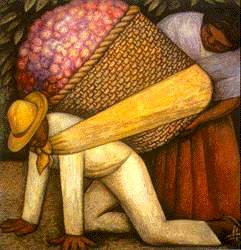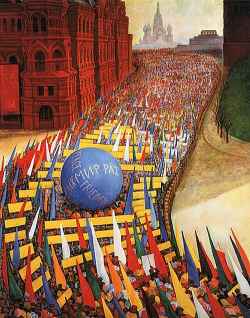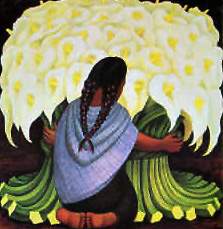Diego Rivera
1886 - 1957 (Guanajuato, México)

Diego María Concepcion Juan Nepomuceno Estanislao of Rivera and Barrientos Acosta and Rodríguez, better known as Diego Rivera, was born in the city of Guanajuato, Guanajuato, the 8 of December of 1886. The talent for the painting was being developed in him throughout his scholastic years.
When Diego was just ten years old, his family moved to the Mexico City. There, he obtained a scholarship of the government to enroll in the Academy of Arts of San Carlos, where he stayed until his expulsion in 1902 for participating in the student revolts of that year.
The influences that Rivera received during his stay in the capital varied, from those of his first teacher, disciple of Ingres, to those of Jose Guadalupe Posada, engraver in whose workshop Diego worked and whose influence would be decisive in his later artistic development.
Five years later, Diego made his first exhibition, that was a great success among the public; this brought him a scholarship of the government of Veracruz to continue its pictorial formation in Spain, in the school of San Fernando in Madrid. From there, Diego Rivera made diverse trips around France, Belgium, Holland and Great Britain, between 1908 and 1910, until finally settling down in Paris in 1911. During this trip he was influenced by the post-impressionism, mainly by the art of Paul Cézanne. This moved him to experience with the cubism and other latest styles, in whose language Diego received some kind of lightness, creating original works full of harmony. In the year of 1910 Rivera also exhibited forty of his works in Mexico, with whose, in spite of not having developed totally the possibilities of his vigorous and emphatic style, he obtained a favorable welcome of the public.

It was always the ambition of Diego Rivera to express in plastic form the events, ideas and hopes of the Mexican Revolution.
In order to find a tool suitable to this expression, Diego had to experiment with the technique of the fresco painting. This technique consists of painting directly on the wet mortar (mixture of lime and sand), so that the color penetrates and, when dries up, fixes it. Again in Europe, Diego Rivera exposed in Madrid and Paris. In 1920 he went to Italy to study the Renaissance fresco painting which are conserved there, and investigated the mural technique of Renaissance italian painter Giotto, whose influence made Diego separate from the cubist movement, and to investigate with greater depth in the social scenes of his environment. Before embarking, Diego had in his portfolio hundreds of sketches to paint them after his return.
Out of the experiences reunited in this trip, Rivera deduced a narrative, linear style of color applied in flat inks, which he used after his return to Mexico, in 1921. Once in his country, Diego Rivera together with Jose Clemente Orozco and David Alfaro Siqueiros founded a pictorial movement, which was then named the Mexican painting school. At that time Rivera worked on the elaboration of frescos for the National Preparatory School of the Mexico City. To this period belongs one of his greatest works, “The fecund Earth” (Tierra fecunda), made for the National School of Agriculture of Chapingo. In 1929 Diego Rivera marries Frida Kahlo.

Diego Rivera was vividly interested in the politics so in his mural, historical and symbolic compositions resonates the voice of the social-revolutionary preaches and of the resistance against the foreign oppression. Some other great mural paintings that can be appraised today are those of the Cortés Palace of Cuernavaca, and those of the National Palace, in the Mexico City, to mention only some.
The murals that Rivera painted in Mexico made it so famous that he became not only the head of pictorial school, but also the political leader. His activities in this last order it have done center of not few controversies and eventful journeys, like, for example, when the Hotel of the Prado refused, in the Mexico City, to exhibit great fresh his in which they appeared the words “God does not exist”, that Diego, as well, refused to let erase, until finally it yielded when returning in 1956 from a trip to Russia made by reasons for health. Diego Rivera was member of the Communist Party from 1923 to 1930 and of 1954 until his death.
The expansion of his fame during the decade 1930 took Rivera to expose his paintings in New York. There he received the order to accomplishment the great murals in the Institute of Detroit Art and in the Rockefeller Center of N. York, where his fresco “Man in the crossroads” (Hombre en la encrucijada) received numerous critics for the similarity of the characteristics of one of his figures with Lenin. The mural was destroyed by the center and replaced by another one of Brangwyn, but Diego soon reproduced it for the Palace of Beautiful Arts of Mexico. In his numerous orders to decorate public buildings, Rivera used the buon fresco technique and the old encaustic painting methods as well.

From end of the 1930 decade, Rivera dedicated his time to the landscape and portrait paintings. In his last paintings he developed an indian and social style, which gained a lot of popularity. Diego's most ambitious and gigantic project, an epic mural of the Mexican history for the National Palace, was left unfinished after his death in the Mexico City in November 25, 1957.
Diego Rivera, in simplified forms and with alive colorful, rescued beautifully the past pre-Columbian, like the most significant moments of Mexican history: the Earth, the farmer and the worker; the customs, and the popular character.
The contribution of Diego Rivera's work to the modern Mexican art was decisive in murals and in easel paintings; he was a revolutionary painter who was looking for a way to take the art to the great public, to the streets and the buildings, handling a precise and direct language with a realistic style, full of the social content.
Parallelly to his creative effort, Diego Rivera unfolded educational activity in his country, and reunited a magnificent collection of Mexican popular art.
The name of Diego Rivera is commonly misspelled as Diego Ribera.
Links - Diego Rivera
Galery of Diego Rivera paintings
Diego Rivera web Museum
Diego Rivera Mural Project
 Frida Kahlo
Frida Kahlo